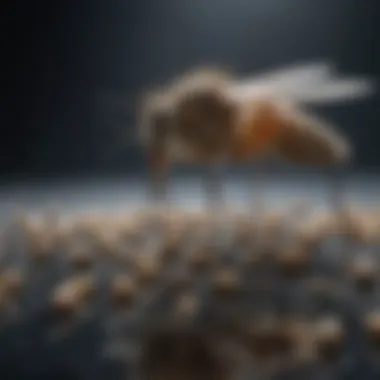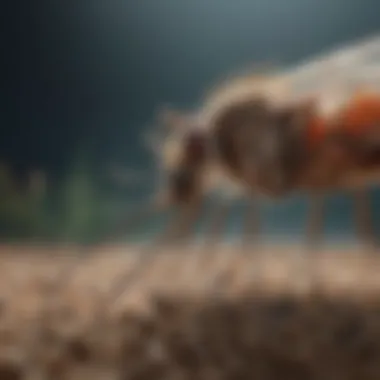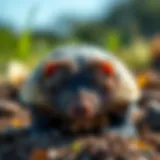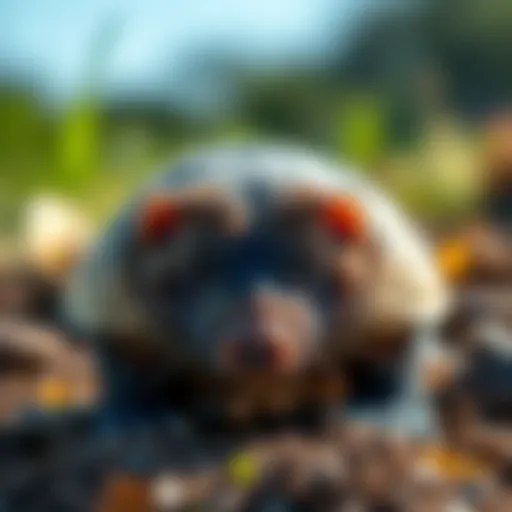Understanding Mosquito Pellets: Efficacy and Impact


Intro
Mosquitoes pose significant health risks and discomfort in various environments. Understanding their behavior and the methods of controlling their populations is essential. One innovative approach involves the use of mosquito pellets, particularly designed for water applications. These pellets offer a targeted solution for managing mosquito populations effectively and are increasingly recognized by homeowners and pest control professionals alike.
This article provides an in-depth exploration of mosquito pellets, focusing on their efficacy, environmental impact, and methods of application. By examining the science behind these products, safety concerns, and integrated pest management strategies, the aim is to equip the reader with comprehensive knowledge that enhances their understanding of mosquito management.
Pest Identification
Identifying mosquitoes is crucial for effective pest management. There are several species commonly found in residential areas. Among these, the Aedes, Culex, and Anopheles mosquitoes are noteworthy. Each species exhibits unique characteristics and behaviors.
Detailed Descriptions of Common Pests
- Aedes Mosquitoes: Known for their distinctive markings, these mosquitoes are often aggressive daytime feeders. They transmit diseases like Zika and dengue.
- Culex Mosquitoes: Generally more active at night, these insects are responsible for spreading West Nile virus. They have a more subdued appearance compared to Aedes.
- Anopheles Mosquitoes: Primarily recognized as malaria vectors, their presence is more prominent in tropical and subtropical regions. Their larvae thrive in clean water.
Signs and Symptoms of Infestations
Recognizing a mosquito infestation can be straightforward. Key indicators include:
- Increased mosquito activity during specific times of day.
- Presence of larvae in stagnant water bodies.
- Unexplained itchiness on exposed skin after being outdoors.
By being vigilant, property owners can take appropriate actions before populations escalate.
Prevention Strategies
Preventing mosquito infestations involves proactive measures. Simple home maintenance techniques can significantly reduce breeding sites and habitat suitability for mosquitoes.
Home Maintenance Tips for Pest Prevention
- Eliminate Standing Water: Regularly check for and remove any standing water around the property, including pots, birdbaths, and clogged gutters.
- Maintain Landscaping: Keep lawns trimmed and shrubbery well-managed to reduce resting sites.
- Install Screens: Ensure that windows and doors have intact screens to prevent mosquitoes from entering.
Natural Deterrents and Barriers
Utilizing plants can also help deter mosquitoes. Some effective options include:
- Citronella: Known for its strong scent, citronella can repel mosquitoes.
- Lavender: The fragrance of lavender is favorable for humans but unappealing to mosquitoes.
By incorporating these strategies, homeowners can create a less hospitable environment for mosquitoes.
Treatment Options
When prevention fails, effective treatments are necessary. This section breaks down available pest control options.
Overview of Chemical vs. Natural Treatments
Chemical treatments often guarantee quicker results, but natural remedies provide a more environmentally friendly alternative. Popular options include:
- Chemical Treatments: Products like Bacillus thuringiensis israelensis (Bti) can be used in water applications. They target mosquito larvae without harming non-target species.
- Natural Treatments: Essential oils, vinegar solutions, and homemade sprays are common natural remedies that offer various levels of efficacy.
Step-by-Step Guides for DIY Treatments
For homeowners interested in a hands-on approach to management, simple DIY treatments can be effective. Here is a straightforward method for creating a natural repellent:
- Combine water and essential oils such as tea tree oil or eucalyptus oil.
- Pour the mixture into a spray bottle.
- Spray around areas where mosquitoes tend to gather, such as patios or decks.
Adopting these methods can enhance one's ability to manage mosquito populations effectively while maintaining a balanced environment.
"Effective mosquito management is a combination of proper identification, prevention, and treatment. Relying solely on one method may not yield satisfactory results."
Foreword to Mosquito Pellets
Mosquito pellets are a key component in the fight against mosquito populations. Their use is increasingly relevant due to the growing awareness of the health risks posed by these insects. Every homeowner knows the annoyance and potential danger insects like mosquitoes bring. Therefore, understanding mosquito pellets can greatly assist in maintaining a safe and comfortable living environment.
Definition of Mosquito Pellets
Mosquito pellets are specialized formulations designed to target mosquito larvae in water bodies. They contain a mix of active ingredients that disrupt the growth or reproduction cycle of mosquitoes. Unlike sprays or other treatments that target adult mosquitoes, these pellets focus on the early life stages of the insect. This makes them particularly effective for long-term management of mosquito populations.
These pellets usually dissolve slowly in water, releasing their active ingredients gradually. This encapsulation allows for a sustained effect, providing ongoing protection against mosquito breeding in stagnant water sources around homes, such as birdbaths, ponds, or clogged gutters.
Purpose and Functionality


The primary purpose of mosquito pellets is to reduce mosquito numbers through targeted action. They function by killing larvae before they can mature into adults, thus preventing further reproduction and the potential spikes in population that can come with warmer months. This is particularly important in areas where standing water is prevalent.
In addition to their primary role in mosquito control, these pellets are designed with safety in mind. They aim to minimize the impact on non-target species, such as fish or beneficial insects. Often, they are formulated to be effective at low concentrations, which makes them more environmentally friendly compared to more traditional pest control methods.
Utilizing mosquito pellets as part of an integrated pest management approach may lead to a more sustainable environment. This method not only addresses the mosquito problem but also considers the overall health of the ecosystem.
"Using mosquito pellets can be a significant step in preventing the spread of diseases carried by mosquitoes, while also promoting a healthier habitat."
The Science Behind Mosquito Pellets
The examination of mosquito pellets highlights significant contributions to pest management strategies. Understanding the science involved provides valuable insights into why these products have gained popularity. This section elaborates on the active ingredients and their mechanism of action, alongside the effectiveness of mosquito pellets against populations. Both elements are essential for evaluating their impact and role in controlling mosquito populations effectively.
Active Ingredients
Common Ingredients
Common ingredients in mosquito pellets often include substances like Bacillus thuringiensis israelensis (Bti) and methoprene. Bti is a naturally occurring bacterium that specifically targets mosquito larvae. Its specificity is notable, as it does not harm other aquatic life, making it a safer choice for diverse ecosystems. Methoprene, on the other hand, disrupts the development of juvenile mosquitoes, thereby preventing them from reaching maturity.
These ingredients contribute to the effectiveness of pellets in controlled settings and broader environments. The unique feature of Bti is its ability to decompose into non-toxic by-products, which reduces harmful residue in water bodies. However, the reliance on chemical agents, even if targeted, necessitates careful application to ensure they do not disrupt non-target species.
Mechanism of Action
The mechanism of action for mosquito pellets is primarily biological or biochemical. For example, Bti works by producing toxic proteins that are ingested by larvae, leading to their death. This targeted approach limits side effects on other species, which is a significant advantage in an ecological context.
Conversely, methoprene functions as a growth regulator, interfering with the normal development of larvae. While this characteristic is beneficial for slowing population growth, its long-term effects on the disturbed habitats are still a matter of ongoing research and debate. Understanding these mechanisms allows users to make informed choices about methods of mosquito control.
Effectiveness Against Mosquito Populations
Studies and Research
Research studies investigating the effectiveness of mosquito pellets have produced substantial evidence supporting their use in various settings. Findings demonstrate that when applied correctly, these products can lead to significant reductions in mosquito populations. The studies often highlight their long-lasting effects, making them a practical solution for homeowners.
Moreover, these studies reveal the role of mosquito pellets in integrated pest management strategies. They can effectively complement other methods of control, showcasing their adaptability and importance in pest control plans. However, it is essential to note that success rates may vary based on environmental conditions and application techniques.
Case Examples
Real-world case examples illustrate the success of mosquito pellets in urban and rural settings. In some regions, communities have adopted these products to combat high mosquito populations, leading to observable decreases in nuisance and disease transmission rates. Such examples are beneficial as they provide tangible evidence of effectiveness and inspire confidence in their use.
Additionally, some cases involve multi-year studies demonstrating sustained habitat health improvements with the use of mosquito pellets. For homeowners, these findings assure that adopting mosquito pellets can yield proportional benefits in mosquito control while preserving ecological balance. Nonetheless, results can vary and necessitate ongoing evaluations.
Application Methods for Mosquito Pellets
Understanding the application methods for mosquito pellets is crucial for their effective use. The manner in which these pellets are utilized significantly impacts their effectiveness, safety, and overall success in mosquito management. Proper application fosters not only targeted results but also minimizes potential negative effects on the environment and non-target species. The following sections will detail the various methods and considerations when applying mosquito pellets in water bodies, ensuring optimal performance.
Proper Usage in Water Bodies
Types of Water Bodies
The effectiveness of mosquito pellets varies across different water bodies. These include stagnant ponds, lakes, bird baths, and artificial containers. Each type of water source can have distinct characteristics that affect how pellets function.
For example, stagnant ponds are often a breeding ground for mosquitoes due to their still water. By applying pellets here, homeowners can directly target larvae growth. On the other hand, flowing water bodies like streams may dilute the active ingredients, making pellets less effective.
Choosing the right water body for pellet application is significant. It enables more effective control of mosquito populations while minimizing chemical dispersion. Furthermore, small pools of water, such as bird baths, allow for easy monitoring and frequent application, enhancing the management efforts.
Recommended Techniques
Applying mosquito pellets requires specific techniques to ensure maximum efficacy. When using these pellets, consider the time of day and environmental conditions. Early morning or late afternoon applications often yield better results as these times correspond with more mosquito activity.
Spread the pellets evenly across the surface of the water. This method ensures that the active ingredients reach various depths, impacting a larger volume of water. Using a measuring tool for precise amounts can also improve effectiveness. Additionally, it is crucial not to exceed recommended dosages, as excessive use may harm non-target species and lead to environmental issues.
Proper techniques also promote longer-lasting results. Some products offer slow-release formulas, requiring less frequent applications. However, in densely populated areas, more frequent checks and applications assure that mosquito populations remain under control without significant chemical runoff in nearby habitats.
Dosage and Frequency of Application
Determining the right dosage and application frequency is pivotal. It guarantees that the treatments remain effective without causing ecological harm. Each product comes with its specific dosage recommendations based on water volume and targeted mosquito species.
Typically, smaller volumes of water may require less product, while larger bodies might demand larger quantities. Keep in mind the suggested duration between applications. Following these guidelines ensures persistent control over mosquito populations without overwhelming the ecosystem.
Properly calculating dosage and frequency is essential to maintaining ecological balance while managing mosquito populations.
Benefits of Using Mosquito Pellets


Using mosquito pellets can offer several advantages, especially for homeowners who aim to manage mosquito populations effectively. The benefits discussed here focus on two main aspects: long-lasting protection from mosquitoes and the reduced environmental impact associated with their use.
Long-Lasting Protection
One of the most compelling reasons to consider mosquito pellets is their ability to provide long-lasting protection. Traditional methods of mosquito control, like sprays, often require frequent reapplication. In contrast, mosquito pellets are designed to dissolve and release their active ingredients slowly and steadily. This slow-release mechanism allows for a sustained reduction in mosquito populations over an extended period.
Additionally, when used in appropriate dosages, mosquito pellets can create a barrier that reduces the number of adult mosquitoes and the larvae in water bodies. Users have reported that after applying these pellets, they notice a significant decrease in mosquito activity. This effect can be especially beneficial during peak mosquito seasons, where proactive management is critical to avoid potential health risks associated with mosquito bites, such as diseases like West Nile virus or Zika.
In summary, mosquito pellets can effectively minimize mosquito populations for weeks or months, providing homeowners with an efficient solution that requires less frequent application compared to other control methods.
Reduced Environmental Impact
Another notable benefit of using mosquito pellets is their potential for a reduced environmental impact. Many modern mosquito pellets are engineered with a keen awareness of ecosystem balance. They primarily target mosquito larvae, which diminishes the risk of affecting beneficial non-target species in the surrounding environment. Compared to traditional insecticides, which may indiscriminately eliminate various insects, mosquito pellets focus on the pests that pose a direct threat to public health.
"Safe and targeted applications of pest control methods ensure a healthier ecosystem."
Moreover, the formulation of these pellets often emphasizes lower toxicity levels. This characteristic means that when the pellets dissolve in water, the active ingredients have less potential to harm other wildlife or affect water quality. By using mosquito pellets, homeowners can engage in an effective pest control strategy without contributing to broader ecological issues.
Safety Considerations
Safety in the context of mosquito pellets is paramount, considering their widespread application in various water bodies. These products are designed to combat mosquito populations effectively. However, it is crucial to examine how they affect other species and the environment as a whole. Understanding the safety considerations involved can help homeowners make informed decisions, enhancing both pest control and ecological balance.
Impact on Non-Target Species
Using mosquito pellets can inadvertently affect species that are not intended targets. Non-target species refer to any organisms that may be harmed by substances designed specifically for mosquito management. The balance of local ecosystems can be delicate. For instance, aquatic life, such as fish and beneficial insects, may succumb to the active ingredients in these pellets.
Research indicates that some common active ingredients, while effective against mosquito larvae, can also disrupt the lifecycle of other aquatic creatures. It is essential for users to be aware of which species inhabit their local environments before application. This awareness can mitigate unexpected negative outcomes. To further protect non-target species, users might consider:
- Checking local regulations regarding mosquito pellet use.
- Conducting a small-scale test in less populated areas before large applications.
- Consulting with local pest control experts for advice specific to their area's biodiversity.
It becomes evident that being informed about potential impacts ensures safer pest control practices.
Guidelines for Safe Use
To maximize efficacy and minimize risks, following established guidelines for safe use of mosquito pellets is advisable. Here are key points to consider when using these products:
- Read Product Labels: Each product comes with manufacturer instructions detailing its use. Following these ensures better results and lowers risk.
- Consider Water Characteristics: The type of water body impacts effectiveness and safety. For example, stagnant water may require different considerations than flowing water.
- Observe Local Wildlife: Before application, take note of any visible wildlife in the area. Avoid zones with high populations of non-target species to reduce potential hazards.
- Timing of Application: Certain times of year may be more suitable than others based on local mosquito lifecycles. Applying during peak mosquito breeding seasons can increase effectiveness.
- Educate the Household: Inform family members about the purpose and application of these pellets to avoid unintended uses or misuse.
By adhering to these guidelines, homeowners can apply mosquito pellets effectively while minimizing risks to non-target species and the environment.
When used with consideration, mosquito pellets can serve as effective tools in integrated pest management without significantly disrupting the local ecological balance. Understanding these safety aspects is as crucial as comprehending their functionality.
Integrated Pest Management (IPM) Practices
Integrated Pest Management (IPM) is vital in modern pest control strategies. It emphasizes the integration of various approaches to provide effective, sustainable solutions against pests, like mosquitoes. The main goal of IPM is to minimize pest populations while reducing risks to human health and the environment. Understanding IPM practices can empower homeowners and pest control professionals to make informed decisions, ensuring a balanced and healthy ecosystem.
Role of Mosquito Pellets within IPM
Mosquito pellets play a crucial role in the IPM framework. They offer a targeted method for reducing mosquito populations in water bodies, where these pests breed. When utilized appropriately, these pellets can drastically lower mosquito numbers without causing significant harm to non-target species. By deploying mosquito pellets as part of an IPM strategy, one can effectively manage and suppress mosquito populations, leading to reduced transmission of mosquito-borne diseases.
Combining with Other Control Measures
Biological Control
Biological control involves the use of natural predators or pathogens to manage mosquito populations. This approach can be a more environmentally friendly option, as it relies on existing ecological relationships. One key characteristic of biological control is its ability to establish balance within ecosystems. Incorporating natural enemies, like certain fish species that eat mosquito larvae, can significantly decrease mosquito numbers without chemical intervention.
The unique feature of biological control is its sustainability; once established, these natural predators can continue to provide pest management without repetitive applications. However, it may have limitations in situations with severe infestations where rapid results are needed. Still, it remains a popular choice for its low ecological footprint and resilience.
Cultural Practices
Cultural practices refer to modifications in human behavior and practices to reduce mosquito breeding sites. These often include practices like proper waste disposal to prevent standing water accumulation and maintaining cleanliness in yards. A key aspect of cultural practices is that they require minimal financial investment while being highly effective when consistently applied.
What distinguishes cultural practices is their focus on prevention over reaction. By altering environments to make them less hospitable to mosquitoes, homeowners can significantly diminish mosquito populations. The advantage here is the potential for long-term effectiveness; however, it requires ongoing commitment and community involvement.
"Integrated Pest Management, particularly when combining mosquito pellets with biological and cultural practices, can significantly impact mosquito control efforts while ensuring environmental responsibility."
Customer Perspectives and Experiences
Understanding customer perspectives and experiences with mosquito pellets is paramount for evaluating their real-world effectiveness. The insights gathered from users not only provide a practical view of how these products perform, but also highlight essential considerations regarding their application and results. Users often share their satisfaction, frustrations, and suggestions, which can guide others in selecting the right products for their specific needs. This section intends to unravel the nuances of customer interactions with mosquito pellets, offering a balanced view that can help both homeowners and pest control professionals make informed decisions.


User Reviews and Testimonials
User reviews serve as a direct reflection of the satisfaction levels among consumers. They often detail personal experiences, which vary widely depending on numerous factors such as local climate, specific mosquito species, and the type of water bodies involved. Collecting feedback from various platforms shows a mix of enthusiastic endorsements and constructive criticisms.
- Positive Feedback: Many users appreciate the long-lasting effects of certain pellets. Customers often mention that products like "Mosquito Dunks" have drastically reduced mosquito populations in their ponds and standing water. Users attribute their increased outdoor comfort to these products, noting fewer bites during social gatherings.
- Constructive Critiques: Some reviews point out challenges in effectiveness and application technique. Users have noted that improper dosage or inconsistent application can lead to lesser results. This emphasizes the need for clear instructions and adherence to recommended practices.
Gathering testimonials from community forums, like Reddit, can provide deeper insights into regional differences in product performance. For instance, one user in a humid area shared their success with specific brands, while another in a drier climate expressed struggles, indicating that local environmental factors play a significant role in effectiveness.
Comparison of Popular Brands
When evaluating mosquito pellets, comparing popular brands is crucial for making the best choice. Different brands offer varying formulations and claims, and understanding these differences helps homeowners select the right product for their needs.
- Mosquito Dunks: These are often praised for their ease of use and effectiveness over a long period. Users report seeing a notable decrease in mosquito populations within weeks of application.
- Natular G30: Some users report a quick reduction in mosquito larvae in stagnant waters. While effective, the cost may be higher than others, leading to discussions about value for money in customer reviews.
- Summit Mosquito Bits: These pellets are recognized for their quick action against larvae. Feedback often highlights their immediate impact, but longevity may be a concern for some users.
Customers should weigh brand effectiveness against price and longevity. Engaging in discussions on platforms like Facebook or Reddit can reveal user experiences beyond initial marketing claims, helping potential buyers make the most informed decision.
"When deciding on a mosquito pellet, consider your specific situation—local climate, type of water, and even your budget. Diverse feedback from users can lead to the best outcome in mosquito management."
Challenges and Limitations
Understanding the challenges and limitations of using mosquito pellets is critical. This section discusses two main aspects: resistance development and environmental concerns. These factors can significantly impact the effectiveness of these products and inform best practices for their use.
Resistance Development
Resistance development is a growing concern in pest management. Mosquito populations can adapt over time to certain active ingredients found in pellets. When they are continuously exposed to the same chemical agents, some individuals may develop resistance. This can make them less susceptible to treatments, creating a cycle where higher concentrations of the active ingredient are needed to achieve the same level of effectiveness.
The implications of resistance are notable. It can lead to increased costs for homeowners and pest control professionals, as stronger doses may be necessary. Additionally, it may reduce the overall efficacy of mosquito pellets, making the ongoing battle against these pests more complex. Therefore, it is essential to rotate the types of mosquito control methods utilized. Strategies could include using biological controls alongside chemical methods.
"Understanding resistance patterns is essential for maintaining effective mosquito management practices."
Environmental Concerns
Environmental concerns also play a significant role in the conversation surrounding mosquito pellets. Introducing these products into natural water bodies can pose risks to non-target species. When not used correctly, there can be unintended consequences on local ecosystems. For example, the presence of certain chemicals can affect aquatic life, disrupting food chains and harming species that are beneficial for the environment.
Furthermore, considerations about long-term ecological impact are vital. There may be detrimental effects on water quality and biodiversity. It is crucial for users to follow recommended guidelines strictly to minimize these risks. For homeowners and pest control professionals, understanding the environmental implications is imperative for responsible pest management.
In summary, awareness of resistance development and environmental concerns is crucial when using mosquito pellets. Recognizing these limitations can aid in making informed decisions about their application, ensuring both effectiveness and ecological responsibility.
Future Trends in Mosquito Management
The development of effective solutions to manage mosquito populations continues to evolve. Understanding the future trends in mosquito management is vital, particularly as climate change and urbanization influence mosquito behavior and habitats. The significance of this aspect cannot be overstated. Homeowners and pest control professionals must remain informed about innovative approaches that prioritize both efficiency and environmental safety.
Innovative Solutions in Pest Control
Innovative solutions in mosquito pest control often focus on biological and ecological methods. One approach gaining traction is the use of genetic engineering. This includes genetically modified mosquitoes that produce offspring unable to survive to maturity. Another promising method is the use of mosquito pheromones, which can disrupt mating patterns and consequently reduce mosquito populations.
Using natural predators to target mosquito larvae in water bodies is also showing promise. For instance, fish species like Gambusia affinis, commonly known as mosquito fish, consume large quantities of mosquito larvae, thereby playing a role in biological control. These methods not only focus on eradication but promote ecosystem balance, addressing the ecological concerns often linked with traditional mosquito control methods.
Potential Role of Technology
The implementation of technology in mosquito management provides a significant advantage. Advanced tools such as drones for aerial spraying of mosquito control substances enable more precise application than traditional methods. This reduces both the quantity of chemicals used and the potential impact on non-target species.
Moreover, the integration of smart traps equipped with sensors allows for real-time monitoring of mosquito populations. These traps can identify mosquito species and their numbers, which helps in tailoring control measures accordingly. Data analytics further enhance this approach by allowing for predictive modeling based on weather patterns and mosquito life cycles.
In addition, smartphone applications are emerging as resources for homeowners to get updates on local mosquito populations and the best control methods to apply. This technology-driven approach provides the public with tools to actively manage their environments.
"As new technologies surface, they promise to make mosquito control more effective while preserving our ecological systems."
In summary, future trends in mosquito management are leaning heavily towards biology-based solutions and technological advancements. These innovations are not only about controlling mosquito populations but also ensuring sustainability and safety for the environment. As these trends develop, they can significantly enhance the efficacy of mosquito management practices for homeowners and pest control experts alike.
Closure and Recommendations
The significance of the Conclusion and Recommendations section in this article cannot be understated. This part synthesizes the information presented throughout the entire discussion about mosquito pellets. It serves to summarize vital insights while also providing actionable guidance for homeowners looking to implement these products effectively. Moreover, this section addresses the overarching objective: integrating mosquito management strategies in a way that ensures both effectiveness against pests and the preservation of a balanced ecosystem.
Summary of Key Insights
The investigation into mosquito pellets has revealed several compelling insights. First, these products are generally effective in reducing mosquito populations when applied correctly. The active ingredients found in these pellets typically target larvae, interrupting their life cycle. Second, the application methods are crucial—different water bodies may require tailored techniques to achieve optimal results. Third, understanding the safety considerations is vital to ensure that non-target species are minimally affected. Finally, the integration of mosquito pellets into an Integrated Pest Management (IPM) strategy highlights their role as a component within a broader approach to pest control.
A well-rounded understanding of mosquito pellets can empower homeowners to take proactive steps in controlling mosquito populations while safeguarding their environment.
Best Practices for Homeowners
Homeowners looking to use mosquito pellets can follow several best practices to maximize effectiveness and minimize environmental risks:
- Choose the Right Product: Not all mosquito pellets are created equal. Research options that are proven effective for your specific region and water types.
- Follow Instructions Carefully: Always adhere to the manufacturer’s guidelines for dosage and application frequency. Overuse can lead to unintended consequences for other aquatic life.
- Monitor Water Conditions: Regularly check the water body and its surrounding environment to gauge the effectiveness of the pellets. Adjust your strategy as needed.
- Consider Environmental Impact: Use mosquito pellets as part of a larger pest control strategy. Integrating them with biological control methods, such as introducing natural predators, can enhance success.
- Educate Yourself: Stay informed about the latest research and developments in mosquito control to adopt progressive methods that minimize ecological disruption.
By adhering to these practices, homeowners can effectively manage mosquito populations, leading to safer and more enjoyable outdoor spaces.



